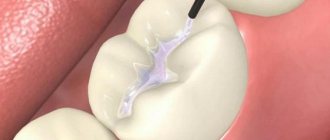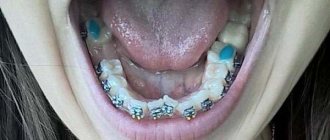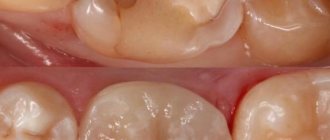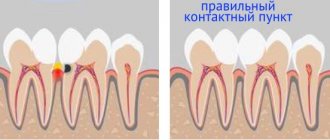30.05.2019
Author: Kudzieva Tamara Valerievna
Progress does not stand still! It is with this obvious truth that I would like to begin today’s article. This applies to all areas of our lives, and by a happy coincidence, dentistry included! Every year, more and more new materials enter the dental market: safer, more aesthetic, and more practical to use. A constantly developing dentist now has in his arsenal high-tech devices and modern materials that allow him to provide high-quality, comfortable, and most importantly, safe dental care.
However, this was not always the case. Just some 10-15 years ago, treatment methods were still actively used that were not only unaesthetic, but also far from safe. The most striking example of this is amalgam fillings.
In historical essays, fillings similar in composition began to be used more than 100 years ago. Amalgam was an alloy of various metals, such as mercury, silver, tin, zinc, copper, etc.
The creation of such a material was made possible thanks to the ability of mercury to dissolve other metals in itself.
Example of an amalgam filling (work taken from the Internet)
Its main advantages were considered to be: strength, lack of visible abrasion and chipping, antiseptic properties of silver, and the ability to inhibit the progression of caries. The last point is very controversial, because under amalgam fillings, in the vast majority of cases, we find a recurrence of caries.
Obvious disadvantages include:
- Low aesthetic characteristics (metallic colored filling);
- Inability to restore the anatomical shape of the tooth (cusps and fissures);
- High thermal conductivity (increased sensitivity when eating cold and hot food);
- Technical difficulties at work.
And last but not least -
- Constantly released mercury vapor into the oral cavity.
The last point is now being studied especially carefully. After all, scientists have proven that mercury is a heavy metal that cannot be eliminated from the body on its own. Moreover, it has a destructive effect on human nerve cells. And if the patient has amalgam fillings in the oral cavity, on the side teeth, the structural elements of these fillings permanently enter the human body. Thus, chronic toxic effects of heavy metals occur.
Doctors all over the world have recognized the harm of amalgam and not only refused to place such materials, but also urgently recommend getting rid of such fillings.
Relatively recently, in the United States, the dental association created standards for the safe removal of amalgam fillings. This is called the SMART protocol. The essence of this protocol is that it is necessary to minimize the contact of the removed filling with the body of the patient, as well as the doctor and assistant.
What is amalgam?
Amalgam is a mixture of metals that has been widely used as a filling material for 150 years.
Dental filling: topic overview
Although sometimes called "silver amalgam", it is actually a mixture of several metals such as silver, mercury, tin and copper. May also contain small amounts of zinc, indium and palladium. Nowadays, materials that are close in color to the natural color of teeth are also used for fillings. Because of this, amalgam is not used as often as in the past.
However, modern materials are not applicable in all cases. Dental amalgam is less expensive than other materials. In addition, over time, it takes root better, especially in teeth that receive the most pressure and become damaged by chewing.
Back to contents
To do this, the following requirements must be met:
- The skin, hair, and clothing of the patient and medical staff must be carefully covered.
- The seal is drilled with a special bur that does not create dust, with the supply of a large amount of water.
- The procedure for removing amalgam fillings is performed in a rubber dam using a hood or vacuum cleaner.
- It is necessary to ventilate the office after this manipulation.
The process of removing an amalgam filling (example provided from the Internet)
All these conditions must be observed, because during the removal of the filling, toxicity increases tenfold.
Important information! Patients during pregnancy and lactation should avoid removing amalgam fillings to avoid negative effects on the child’s body.
At the Atribeaute Clinique aesthetic dentistry department, strict monitoring of compliance with the SMART protocol is carried out. After excision of amalgam fillings, we carry out restoration with a composite material that can completely restore the aesthetic and functional characteristics of the tooth, while remaining 100% safe and hypoallergenic for the entire period the restoration is in the oral cavity.
Tooth restoration with Enamel composite material (the work of dental therapist Tamara Valerievna Kudzieva)
Should women get amalgam fillings?
The study found no negative effects of amalgam fillings on the health of pregnant women. However, mercury can cross the placenta. In general, dentists recommend that pregnant women avoid any dental surgery unless it is necessary.
Pregnant women should not have amalgam fillings. If a pregnant woman needs to fill a cavity in her tooth, her dentist may advise her to get a filling made from a different material.
Back to contents
If the filling falls out
Proper installation of the seal eliminates the risk of it falling out. However, visitors come to our clinic complaining of similar cases after treatment in other places. Most often they occur due to the low qualifications of the doctor and the use of low-grade materials. Loss of tightness and the appearance of cracks at the filling site can also be caused by saliva getting into the treated area. Sometimes installing a filling is not suitable for a particular case at all: the carious cavity is too large, the plug cannot withstand the chewing load and falls out. The doctor should have chosen a different treatment method. In addition, natural shrinkage must be taken into account. If you install a filling without adjusting for this factor, over time the material will shrink, creating a gap between the wall and the composite, opening the way into the structure for dangerous microbes. But doctors are not always to blame. One of the reasons why problems arise after installing a filling is non-compliance with medical recommendations. What is the patient required to do?
- Conduct a preventive examination at least once every six months. For the first time after treatment, it is better to see a doctor monthly.
- Do not eat or drink for several hours after the filling is installed. You should refrain from smoking and drinking alcohol for 2-3 days.
- Protect the body from colds, hypothermia, overheating. Even ordinary ailments can provoke rejection.
- After installing a permanent filling, you should not eat solid food for a week, allowing the new product to successfully integrate into the oral cavity.
- It is advisable to get rid of bad habits: grinding your teeth, biting your nails. You should not visit the bathhouse or experience heavy physical exertion.
- Despite the practicality of modern products, it is better to exclude foods containing strong dyes from the diet.
Installing a filling on a tooth is a simple and effective way to restore the functional and aesthetic properties of the tooth. However, despite the popularity of the procedure, often even the most basic manipulation causes discomfort and pain in the patient. If you entrust a responsible matter to professionals, this will not happen. It is no coincidence that more and more people are turning to the VivaDent clinic to have a filling installed. We employ highly educated specialists who constantly improve their skills. We spare no time in studying the advanced filling installation techniques used in the world and use the best practices in our practice. We guarantee painless treatment and successful results that will exceed your wildest expectations. Installing a filling in our clinic will allow you to completely restore chewing functions and give you the opportunity to give a radiant smile to others. You can make an appointment at a convenient time by phone or using online chat on the website, where specialists are always happy to answer your questions.
Stages of filling
Before applying a filling, the dental cavity is prepared, including:
- hygienic cleaning;
- anesthesia;
- rubber dam application.
Main stage:
- Preparing a cavity for filling. The cavity is isolated from saliva, dried, and a cement lining is applied.
It is necessary to isolate the tooth tissues from the composition, which, without a gasket, can cause pain from temperature stimuli (when hot and cold contact the tooth).The optimal thickness of the gasket is 1.0-1.5 mm. Its substitute can be modern bonding agents that reliably close the dentinal tubules. In addition to this, they contribute to a better marginal seal of the filling.
- Mixing the mass .
Lasts from 15 seconds to a minute depending on the brand of the mixture (taken according to the instructions). You can check the correct preparation by squeezing the mixture with your fingers. It should make a crepitating (crispy) sound and not crack. (You need to squeeze with gloves or through gauze - not so much for your own safety, but in order to avoid disruption of the crystallization of the mixture due to fat and sweat contained on the fingers). - Introduction into the cavity. You need to add in small portions, condensing each portion completely, rubbing the material against the walls of the cavity with a plugger.
Excess mercury released on the surface during condensation must be removed. The next portion is added only after the first one has completely condensed. The last portion is added so that the cavity is filled with a slight excess. If there is no wall on one side, a thin plate secured with a matrix holder is used instead. - Seal modeling. If excess mass forms, it is removed with a cotton swab.
Sagging on the tooth surface must be removed with an excavator, otherwise they will break off and cause leaks between the cavity wall and the filling. If necessary, fissures are formed. To check occlusion, the teeth are closed. If a tubercle of an antagonist tooth is imprinted on the filling, the height of the filling is adjusted. - Sanding and polishing. It is carried out one day after filling. A properly ground and polished filling has a mirror-like shine, and there is no boundary between the filling and dentin (checked with a probe).
Features of the use of profiles in dentistry and their varieties.
In this publication, read about methods of root canal obturation.
Follow the link https://zubovv.ru/lechenie/zubyi/plombyi/material-estelayt-lider.html if you are interested in instructions for using the Estelayt filling material.
Plastics and composites
An extensive group that includes:
- Acrylic-containing plastics. They are resistant to abrasion, but at the same time porous and quite toxic, so they have been used less and less in recent years.
- Composites with epoxy resins (chemically cured). Slightly better than plastic, but quite fragile and darken a few years after installation.
- Light-curing composites (photopolymers). Strong, reliable and durable. They polymerize and harden under the influence of ultraviolet radiation. The composition of a photopolymer tooth filling includes porcelain, which gives the material strength and aesthetics. The most popular option today.
Filling or tab?
Many patients do not understand the difference between installing fillings and installing inlays. Let me explain. Filling is performed for average caries, if the affected area is not too large. Modern light-polymer products are attached to the walls after completion of therapeutic procedures using a special adhesive composition. Under the rays of a special lamp (hence the name), the semi-liquid substance quickly hardens, so that the filling can be installed in one visit to the doctor. A rich palette of colors allows you to choose the shade that best suits your own base. Inlays, most of which are made of ceramics, perform much broader functions. The elements restored in this way are distinguished by high strength, practicality, and durability. To the question “Which is better: installing a filling or an inlay?” It’s impossible to answer unequivocally; it all depends on specific goals. The decision is made by the doctor, but the tabs have a number of undeniable advantages:
- excellent aesthetics;
- high strength;
- long service life;
- favorable payback;
- no shrinkage;
- fissures are not trying.
ON A NOTE! If you need to install a filling inexpensively and quickly, without thinking about the future, then photopolymer materials are an excellent choice for any patient. However, if the teeth are prone to abrasion and the filling material often needs to be replaced, then inlays are more rational - because they do not require constant expansion of the carious cavity for sanitation and treatment.
Compound
Amalgam is a cold alloy of metal (copper, silver) with mercury, obtained by amalgamation (dissolution of metals with mercury with mutual penetration into each other and the formation of intermetallic compounds (Ag3Sn).)
Immediately after amalgamation, the filling material becomes plastic. As the mercury dissolves the alloy particles and disappears freely from the mixture, the amalgam hardens. The hardness value corresponding to occlusal loads is achieved after 24 hours.
The basis of currently used amalgams is silver. The filling material contains the following components:
- Silver (65-73%). The element ensures the hardness of the filling, gives it corrosion resistance, reduces fluidity, and causes expansion of the filling in the tooth cavity.
- Tin (25-29%). Slows down the hardening of the mixture, accelerates emulsification, but at the same time reduces hardness and increases shrinkage.
- Copper (2-6% in silver amalgam, higher in copper amalgam). Increases the strength of the material, ensures a high-quality fit of the filling to the edges of the dental cavity, and makes the filling mass more uniform.
- Zinc (up to 2%). Prevents the formation of oxides (reduces the oxidation of metals), reduces fragility, increases ductility and handling properties. When exposed to moisture, the element is capable of causing too much volumetric expansion.
- Mercury (40-53% – initial content). The final Hg content varies between 37-48% depending on the filling method.
The purpose of root canal irrigation and the drugs used.
Let's find out together here in what case vertical condensation of gutta-percha is prescribed.
At this address https://zubovv.ru/lechenie/zubyi/plombyi/metodom-lateralnoy-kondensatsii.html we will talk about filling root canals using the lateral condensation method.
If amalgam is safe, why does the dentist take precautions when handling it?
Since dentists come into contact with mercury almost daily, they must take precautions. Without protection, mercury vapor can enter the respiratory tract with air. And this can over time lead to manifestations indicating mercury poisoning.
To make dental amalgam, dentists mix liquid mercury with a powder containing silver, tin and other substances.
Dentists buy special capsules that contain such powder and liquid mercury, separated from each other by a special film. They use a special machine to pierce the film and mix the powder with the mercury while it is still in the capsule. After mixing, the capsule is immediately opened. By the time the amalgam is placed into the tooth, the mercury has already combined with other metals. It is no longer toxic.
If you decide to get an amalgam filling or are having one removed, your dentist will use a high-powered suction device to remove any excess amalgam in your mouth. Dental offices have special devices for removing excess amalgam. Special filters in the sink drainage system and suction tubes prevent amalgam from entering the drainage system.
Back to contents
Temporary and permanent plugs
The installation of temporary fillings has the main goal of isolating the cavity for the period of treatment of the disease. If previously this time was no more than 2-3 days, then the latest generation materials are able to retain their original properties for six months. The indication for temporary placement of a filling is a suspected diagnosis that requires confirmation. So, if the pain has not started, then the nerve is fine, you can install a permanent product. In addition, when the dental nerve is removed by killing and mummification, the hole is closed after applying the medicine. When the cavity is cleared of affected tissue, a permanent filling is installed. The requirements for temporary products are no less strict than for permanent ones, because during treatment it is necessary to exclude the slightest risk of penetration of bacteria and microbes from the outside. Therefore, they must be moisture-resistant, sealed, and plastic. When installing temporary and permanent fillings, different materials are used that meet the listed characteristics.
- For temporary ones: dentin paste based on petroleum jelly and glycerin, which has high plasticity and environmental safety; Vinoxol, which provides excellent adhesion; zinc-eugenol or polycarbosylate cement, characterized by excellent tissue compatibility and rapid survival.
- For permanent ones: the materials listed in the first section, the most popular of which is light-curing composite. It is perfect for installing fillings on the front teeth, because the main task of permanent products is to create an attractive smile. Nanocomposites are becoming increasingly widespread.
ATTENTION!
The installation of a good filling is invisible, durable, and reliable. This is especially true when working with chewing teeth, where the load is high. VivaDent clinic fully meet the criteria of strength and reliability .
A little bit of history
Filling, as a way to restore tooth function, has been used since time immemorial. Documentary artifacts from the 1st century AD preserve a description of lead used as a filling.
Dentists in Europe greeted the first appearance of silver amalgam, proposed as a filling material, with great hopes. This happened in Paris in 1826.
Subsequent events showed that the enthusiasm was completely justified. Silver amalgam has many of the properties necessary for a quality filling material. With one exception - it does not allow you to give the restored tooth a natural color.
Amalgam has been used in dental treatment for more than 100 years, and to this day has not lost its practical value as a filling material for carious cavities in lateral teeth - where an aesthetic effect is not required.
Today, amalgam is used primarily to fill cavities in chewing teeth.
Are there alternatives to amalgam?
Now there is dental amalgam that, along with mercury, also contains indium. Indium helps retain mercury, which helps reduce its release into the atmosphere. There are also amalgams with a high tin content, in which there is more tin and, on the contrary, less mercury.
Dentists also use other substances for filling:
- composite plastic,
- porcelain,
- gold,
- ceramics.
Amalgam is stronger than composite resin, and fillings using amalgam are faster. Composite resin is a material that is close to the natural color of teeth. Since such fillings deteriorate more quickly than amalgam fillings, composite resin is not acceptable in all cases.
Back to contents
What other consequences could there be?
Amalgam fillings can cause some chronic disease - for example, periodontitis, or gum disease. They have been shown to cause gum problems in at least nine separate studies, says University of Calgary associate professor Murray Vimy.
“Periodontitis is one of the most common chronic diseases, and fillings containing mercury contribute even more to this. The ADA (US Dental Association) and its advisors may be deliberately misleading the public with the help of the press, or they may not have enough information about scientific studies on the leakage of mercury from amalgam fillings, the results of which are published in their own scientific publications,” the professor argues. .











